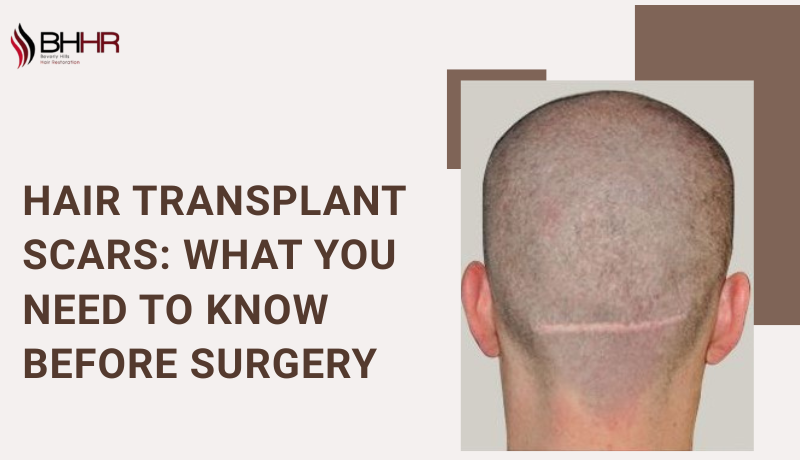Are you thinking about getting a hair transplant but concerned about scarring? You’re not alone. Many people worry about visible scars after surgery—a valid concern. Fortunately, modern hair restoration techniques like FUE and FUT have come a long way, often leaving minimal or barely noticeable scars. Still, every method has its healing process and potential for scarring. Some leave tiny dot-like scars, while others may leave a fine linear mark. Understanding the differences before your procedure can help you make the right choice for your hair goals. This guide will explore what causes hair transplant scars, how to minimize them, and which method might be best for you. Let’s clear up the confusion—starting now.
What Are Hair Transplant Scars?
Let’s get the basics straight first. Hair transplant scars are the marks left behind after hairs are harvested from the donor area (usually the back of the head) and transplanted to thinning or balding areas. Every surgery—no matter how advanced—leaves some trace. However, the type and visibility of the scar depend heavily on the surgical method used and how your body heals.
FUE vs. FUT: Understanding the Difference
FUE (Follicular Unit Extraction)
This method involves removing individual follicular units using a tiny punch device. It’s less invasive and doesn’t require stitches. The result? Tiny, dot-like scars scattered across the donor area. These are usually not noticeable unless you shave your head very short.
FUT (Follicular Unit Transplantation)
In FUT, a strip of scalp is removed from the donor area, and the hairs are dissected and implanted into the target area. This procedure leaves a linear scar, which can be noticeable if your hair is short but easily hidden with longer hair.
Are Hair Transplant Scars Permanent?
Yes, hair transplant scars are technically permanent—but that doesn’t mean they’ll always be visible. These scars can be virtually undetectable with the right surgeon, advanced techniques, and good aftercare. Over time, they often fade and become much less noticeable. However, poor technique or improper healing can result in more pronounced scarring, so choosing an experienced clinic is crucial.
Factors That Influence Scarring
Here’s the deal: everyone’s body responds differently to surgery. But there are a few common factors that can increase the visibility of hair transplant scars:
- Surgical Technique: The method used (FUE vs. FUT) plays a significant role.
- Skill of the Surgeon: An experienced surgeon can minimize scarring.
- Skin Type: Some skin types are more prone to keloid or hypertrophic scarring.
- Aftercare: Proper post-op care can significantly reduce scarring.
- Hair Style Choices: Short haircuts might reveal scars more easily.
How to Minimize Hair Transplant Scars
Luckily, there are several ways to keep scarring to a minimum:
- Choose the Right Surgeon: Look for a clinic with a proven track record and plenty of before-and-after photos.
- Stick to Aftercare Instructions: Your doctor will give you a list of do’s and don’ts. Follow them religiously.
- Avoid Heavy Exercise Early On: Strenuous activity can strain the healing area.
- Stay Hydrated and Eat Well: Good nutrition helps your skin recover faster.
- Avoid Smoking and Alcohol: These can delay healing and worsen scarring.
Can Scars Be Treated or Removed?
Absolutely! Modern techniques can effectively reduce or conceal hair transplant scars:
- Smart FUE: An advanced version of FUE that uses finer tools and precision techniques to leave minimal, nearly invisible scars in the donor area.
- Smart FUT: This technique improves the traditional FUT method by minimizing the width and visibility of the linear scar through refined closure techniques.
- SMP (Scalp Micropigmentation): A non-surgical solution that uses micro-needles to deposit pigment into the scalp, camouflaging scars and giving the appearance of fuller hair coverage.
Common Myths About Hair Transplant Scars
There’s a lot of misinformation floating around when it comes to hair transplant scars. Let’s clear up a few common myths.
“FUE leaves no scars.”
That’s false. While FUE scars are tiny and spread out, they are still scars—just much less noticeable than traditional ones.
“Scars always look terrible.”
Not anymore. With modern surgical techniques and skilled surgeons, most scars are minimal and often undetectable, especially when hair is kept slightly longer.
“Only FUT causes scarring.”
Wrong again. Both FUT and FUE result in some level of scarring. The key difference lies in the type—linear in FUT and dot-like in FUE—and how visible it becomes over time.
Is FUE Always the Better Choice?
FUE might sound like a no-brainer if you’re trying to avoid hair transplant scars, but it’s not necessarily the best option for everyone. FUE takes longer, can be more expensive, and might not provide as many grafts in a single session. Conversely, FUT can yield more grafts simultaneously and is ideal for patients needing extensive coverage. Your surgeon should help you decide which approach suits your needs and lifestyle.
Realistic Expectations Are Key
Let’s be real: if you expect a scar-free scalp, you might be disappointed. No surgery is entirely without its marks. The key is to have realistic expectations and focus on overall improvement. Hair transplants can dramatically boost your appearance and confidence when done right—with minimal visible scarring.
Conclusion
When it comes to hair transplant scars, knowledge is power. While scarring is a natural part of any surgical process, the good news is that modern techniques like FUE have made them less of a worry than ever before. With the right surgeon, good aftercare, and realistic expectations, most patients find the benefits far outweigh any minor marks. Still unsure? Don’t hesitate to consult a reputable clinic. Beverly Hills Hair Restoration offers personalized treatment plans, advanced scar-minimizing procedures, and a hair transplant specialist who understands the importance of aesthetics and comfort. Ultimately, a little scar is a small price to get your confidence and hair back on track. Book your consultation today and take the first step toward a fuller, more confident you!




